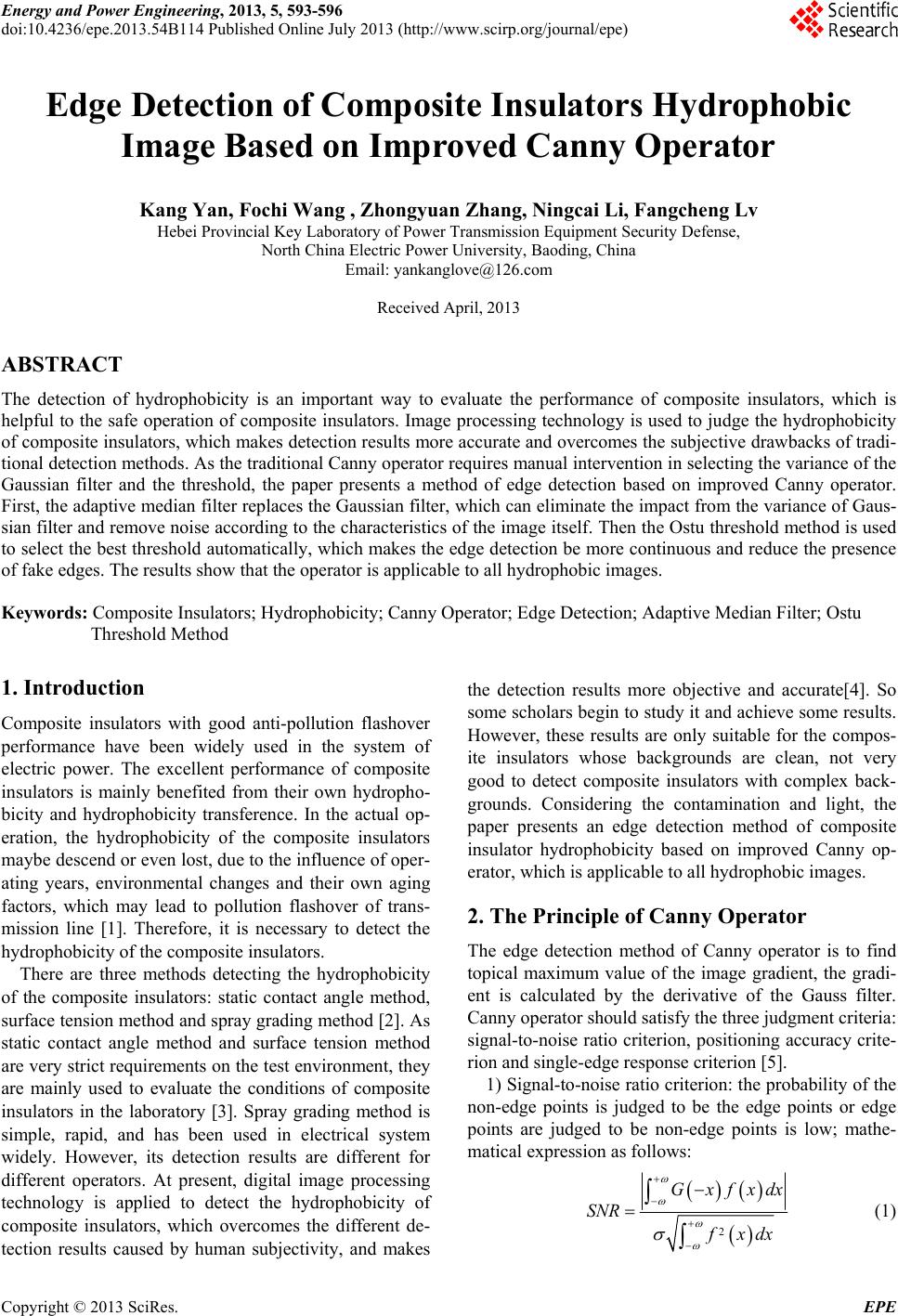
Energy and Power Engineering, 2013, 5, 593-596
doi:10.4236/epe.2013.54B114 Published Online July 2013 (http://www.scirp.org/journal/epe)
Edge Detection of Composite Insulators Hydrophobic
Image Based on Improved Canny Operator
Kang Yan, Fochi Wang , Zhongyuan Zhang, Ningcai Li, Fangcheng Lv
Hebei Provincial Key Laboratory of Power Transmission Equipment Security Defense,
North China Electric Power University, Baoding, China
Email: yankanglove@126.com
Received April, 2013
ABSTRACT
The detection of hydrophobicity is an important way to evaluate the performance of composite insulators, which is
helpful to the safe operation of composite insulators. Image processing technology is used to judge the hydrophobicity
of composite insulators, which makes detection results more accurate and overcomes the subjective drawbacks of tradi-
tional detection methods. As the traditional Canny operator requires manual intervention in selecting the variance of the
Gaussian filter and the threshold, the paper presents a method of edge detection based on improved Canny operator.
First, the adaptive median filter replaces the Gaussian filter, which can eliminate the impact from the variance of Gaus-
sian filter and remove noise according to the characteristics of the image itself. Then the Ostu threshold method is used
to select the best threshold automatically, which makes the edge detection be more continuous and reduce the presence
of fake edges. The results show that the operator is applicable to all hydrophobic images.
Keywords: Composite Insulators; Hydrophobicity; Canny Operator; Edge Detection; Adaptive Median Filter; Ostu
Threshold Method
1. Introduction
Composite insulators with good anti-pollution flashover
performance have been widely used in the system of
electric power. The excellent performance of composite
insulators is mainly benefited from their own hydropho-
bicity and hydrophobicity transference. In the actual op-
eration, the hydrophobicity of the composite insulators
maybe descend or even lost, due to the influence of oper-
ating years, environmental changes and their own aging
factors, which may lead to pollution flashover of trans-
mission line [1]. Therefore, it is necessary to detect the
hydrophobicity of the composite insulators.
There are three methods detecting the hydrophobicity
of the composite insulators: static contact angle method,
surface tension method and spray grading method [2]. As
static contact angle method and surface tension method
are very strict requirements on the test environment, they
are mainly used to evaluate the conditions of composite
insulators in the laboratory [3]. Spray grading method is
simple, rapid, and has been used in electrical system
widely. However, its detection results are different for
different operators. At present, digital image processing
technology is applied to detect the hydrophobicity of
composite insulators, which overcomes the different de-
tection results caused by human subjectivity, and makes
the detection results more objective and accurate[4]. So
some scholars begin to study it and achieve some results.
However, these results are only suitable for the compos-
ite insulators whose backgrounds are clean, not very
good to detect composite insulators with complex back-
grounds. Considering the contamination and light, the
paper presents an edge detection method of composite
insulator hydrophobicity based on improved Canny op-
erator, which is applicable to all hydrophobic images.
2. The Principle of Canny Operator
The edge detection method of Canny operator is to find
topical maximum value of the image gradient, the gradi-
ent is calculated by the derivative of the Gauss filter.
Canny operator should satisfy the three judgment criteria:
signal-to-noise ratio criterion, positioning accuracy crite-
rion and single-edge response criterion [5].
1) Signal-to-noise ratio criterion: the probability of the
non-edge points is judged to be the edge points or edge
points are judged to be non-edge points is low; mathe-
matical expression as follows:
2
Gxfxdx
SNR
xdx
(1)
Copyright © 2013 SciRes. EPE